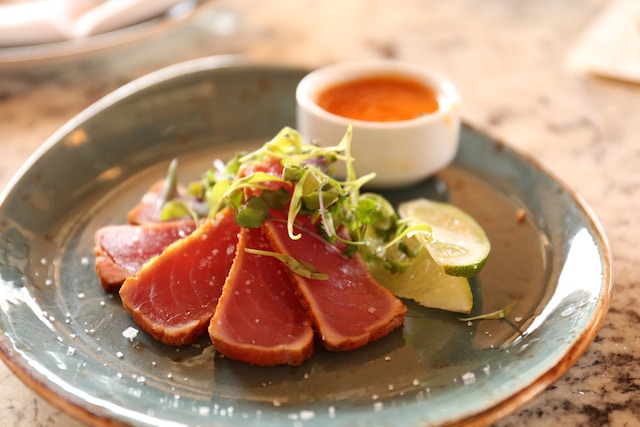
As the world becomes more interconnected, global cuisine has become a ubiquitous part of metropolitan living. From sushi to ramen, Japanese cuisine has gained immense popularity for its bold, umami flavors and impeccably designed presentations. What many don’t know, however, is that Japanese cuisine is deeply connected to its history and culture.
See also: Start Learning Japanese Today
Essential Ingredients in Japanese Cuisine
Japanese cuisine is known for its use of fresh and high-quality ingredients that are often locally sourced. From the umami flavor of dashi to the vibrant colors of seasonal vegetables, Japanese cuisine celebrates the natural flavors and beauty of each ingredient. Here are some essential ingredients that you will commonly find in Japanese cooking:
Rice
Rice is the staple food of Japan, and it is an essential ingredient in many Japanese dishes. Japanese rice is a short-grain variety that is extremely sticky and is perfect for making sushi and rice balls.
Different types of rice: There are many different types of rice used in Japanese cuisine. Some of the most popular varieties are mochigome, which is used to make mochi (a sweet rice cake), and koshihikari, which is considered to be the most premium variety of rice.
Cultural and culinary significance: Rice is a key component of the Japanese diet and is often served with a variety of dishes such as grilled fish, sushi, and tempura. It also has cultural significance as it is used in many traditional ceremonies and festivals.
Dashi
Dashi is a broth made from simmering dried kelp and bonito flakes in water. It is a key ingredient in many Japanese dishes and is known for its umami flavor.
Different types of dashi: There are a few different types of dashi that are commonly used in Japanese cuisine. These include kombu dashi, which is made with only dried kelp, and awase dashi, which is made with both dried kelp and bonito flakes.
Cultural and culinary significance: Dashi is a fundamental ingredient in Japanese cuisine and is used in a variety of dishes such as miso soup, udon noodles, and tempura batter. It is considered to be the backbone of Japanese cooking and is essential for achieving the signature umami flavor that is characteristic of Japanese cuisine.
Soy Sauce
Soy sauce is a dark, salty sauce made from fermented soybeans. It is a versatile ingredient that is used in a wide variety of Japanese dishes.
Different types of soy sauce: There are many different types of soy sauce used in Japanese cuisine. The most common ones are koikuchi, which is the standard soy sauce used for cooking, and usukuchi, which is a lighter variety of soy sauce that is commonly used in dishes that require a more delicate flavor.
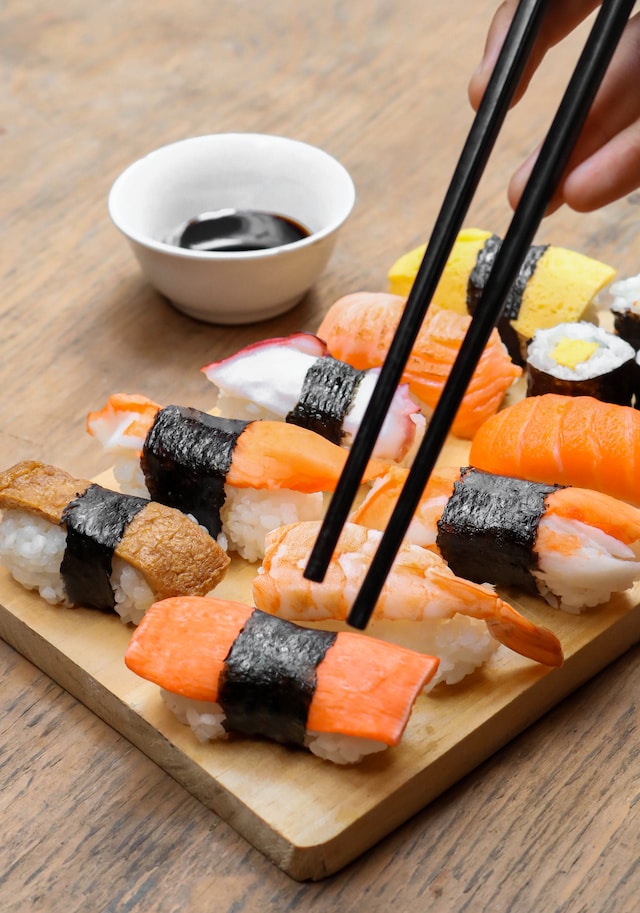
Cultural and culinary significance: Soy sauce has been used in Japanese cuisine for centuries and is an indispensable ingredient in dishes such as teriyaki, sukiyaki, and shabu-shabu. It is also used as a dipping sauce for sushi and sashimi, and as a seasoning for rice and noodles.
Mirin
Mirin is a sweet, rice-based wine that is commonly used in Japanese cooking. It has a low alcohol content and a mild, sweet flavor that helps to balance out the salty and savory flavors in dishes.
Different types of mirin: There are two main types of mirin: hon-mirin, which is a premium variety that is made with higher-quality ingredients, and mirin-fu chomiryo, which is a cheaper, inferior version that is commonly used in commercial cooking.
Cultural and culinary significance: Mirin is an important ingredient in many Japanese dishes, such as teriyaki sauce, glazes for grilled fish, and nikujaga (a meat and potato stew). Its sweetness helps to balance out the salty and savory flavors in dishes and adds a depth of flavor to many Japanese dishes.
Traditional Japanese Dishes
Sushi
Sushi is probably one of the most famous Japanese dishes and is made of vinegared rice that is topped with seafood, vegetables, or meat. Sushi is known for its unique combination of flavors and textures, and traditionally, it is served with soy sauce, wasabi, and pickled ginger. There are different types of sushi, including nigiri (hand-pressed sushi), maki (rolled sushi), and temaki (hand-rolled sushi).
Brief history: Sushi has been around since the Edo period (1603-1867) and originally started as a street food. Today, sushi can be found in restaurants all around the world and has become one of Japan’s most famous culinary exports.
Etiquette and Dining Customs: When eating sushi, it is important to use chopsticks or your hands to pick up the sushi. Be sure to dip the sushi in the soy sauce, fish side down, and avoid adding too much wasabi, which can overpower the flavors of the sushi.
Ramen
Ramen is a noodle soup dish that typically consists of Chinese-style wheat noodles served in a meat or fish broth, with toppings such as sliced pork, bamboo shoots, nori seaweed, and green onions. The broth for ramen can be varied, depending on the region and the type of ramen. Ramen can be savory, spicy, or sweet, and there are hundreds of variations of the dish.
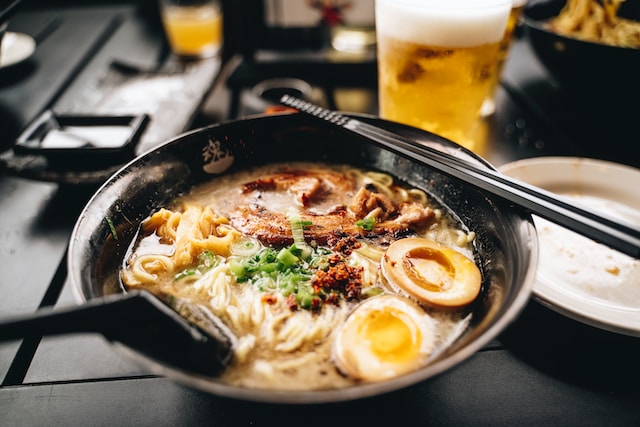
Brief history: Ramen originated in China but was introduced to Japan during the Meiji period (1868-1912). The dish became popular in post-WWII Japan and has since become a staple of Japanese cuisine.
Etiquette and Dining Customs: When eating ramen, it is common to slurp the noodles. This is not considered rude in Japan but is actually a sign that the food is delicious. It is also important to use chopsticks when eating ramen and to avoid splashing the broth on your clothes.
Sukiyaki
Sukiyaki is a hot pot dish that is traditionally made with thinly sliced beef that is cooked in a hot broth with vegetables and tofu. The broth for sukiyaki is usually made with soy sauce, sugar, sake, and mirin and is cooked in a special pot called a sukiyaki pot. The ingredients are then dipped in raw beaten eggs before being eaten.
Brief history: Sukiyaki has been around since the Meiji period and is said to have originated in the Edo (now Tokyo) region. The dish has since become a popular winter dish in Japan.
Etiquette and Dining Customs: When eating sukiyaki, it is customary to cook the ingredients in the hot pot and then dip them in the raw beaten eggs before eating. It is also common to drink sake or shochu while eating sukiyaki.
Tempura
Tempura is a dish of seafood or vegetables that are battered and deep-fried until crispy. Tempura is known for its light and crispy batter, which is made from flour and cold water. Common ingredients for tempura include shrimp, squid, fish, eggplant, and sweet potatoes.
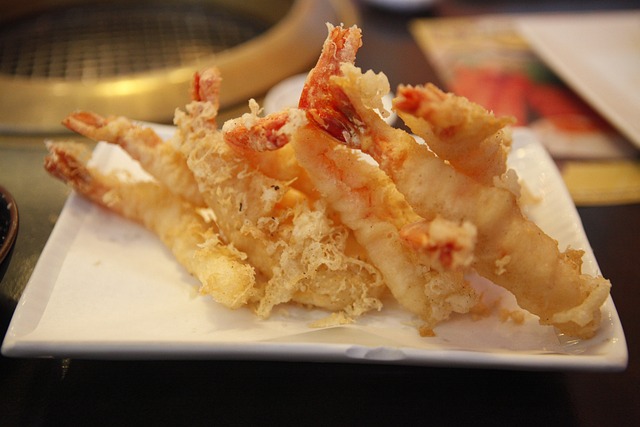
Brief history: Tempura was introduced to Japan in the 16th century by Portuguese traders and has since become a beloved dish in Japanese cuisine.
Etiquette and Dining Customs: When eating tempura, it is customary to dip the ingredients in a special dipping sauce made of dashi, soy sauce, and mirin. It is also important to eat tempura quickly, while it is still hot and crispy.
Okonomiyaki
Okonomiyaki is a savory pancake or omelette that is made with a variety of ingredients, including cabbage, seafood, meat, and vegetables. The ingredients for okonomiyaki are mixed together and then cooked on a griddle. There are different styles of okonomiyaki, including the Hiroshima-style, which is made with noodles, and the Osaka-style, which is made with a batter.
Brief history: Okonomiyaki has been around since the Edo period but became popular as street food in the post-WWII era. Today, the dish has become a staple of Japanese cuisine and can be found in restaurants all around the world.
Etiquette and Dining Customs: When eating okonomiyaki, it is customary to top the pancake with special sauce and mayonnaise before eating. It is also common to cook the pancake yourself on a griddle at the table.
Fusion and Modern Japanese Cuisine
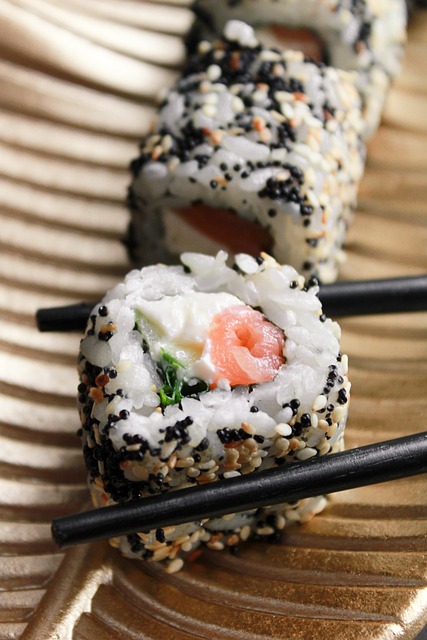
In recent years, Japanese cuisine has undergone a transformation, with chefs experimenting with new ingredients and techniques to create innovative dishes that blend traditional flavors with international culinary traditions. This fusion of different culinary traditions has led to the emergence of modern Japanese cuisine, which is characterized by its distinctively contemporary twist on classic Japanese dishes.
Influence of International Flavors on Japanese Cuisine
The globalization of food culture has led to an influx of international flavors and ingredients into Japanese cuisine. The influence of Italian, French and Spanish cuisine, in particular, has been felt in Japanese kitchens. Chefs have experimented with incorporating cheeses, cured meats, and olive oils into traditional Japanese dishes to create fusion dishes that offer a new take on old favorites. Some examples include:
1. Italian-Japanese: Japanese-style pizza featuring toppings such as tuna and mayonnaise or teriyaki chicken and seaweed.
2. French-Japanese: Foie gras sushi or croissant filled with adzuki bean paste.
3. Spanish-Japanese: Spicy chorizo served with dashi broth or sushi rolls filled with paella ingredients like saffron, seafood, and chicken.
Japanese chefs have taken traditional ingredients and techniques and turned them into something innovative and new. Molecular gastronomy has been applied to Japanese cuisine, creating dishes such as sake jelly, miso foam, and soy sauce caviar. Chefs are also using unique ingredients like truffles, caviar, and uni to create dishes that are not traditionally Japanese but are a reflection of the creativity and ingenuity of Japanese cuisine.
Japanese Tea Culture
Tea has played a vital role in Japanese culture since it was first introduced from China in the 9th century. Japan has since developed its own unique tea culture and is world-renowned for its high-quality teas such as matcha and sencha.
Matcha
Matcha is a finely ground green tea powder that is famous for its use in the Japanese tea ceremony, or chanoyu. Matcha is made from shade-grown tea leaves that are ground into a fine powder and whisked with hot water to create a smooth and creamy tea with a distinct umami flavor.
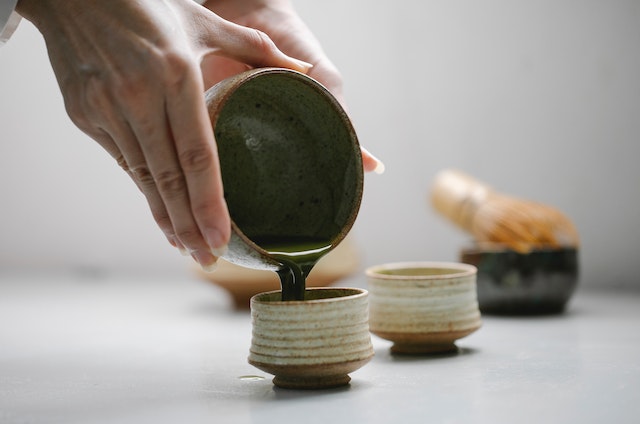
Sencha
Sencha is the most commonly consumed tea in Japan and is made by steeping whole tea leaves in hot water. It has a fresh and grassy flavor and is often enjoyed with meals.
Tea Ceremony and its Significance in Japanese Society
The Japanese tea ceremony, or chanoyu, is a traditional practice that dates back to the 16th century. It is a formalized ritual that involves the preparation and presentation of matcha in a specific way, with careful attention paid to every detail from the utensils to the movements of the host.
The tea ceremony is considered to be an important part of Japanese culture and is a way of fostering community and facilitating social interactions. It is also seen as a way of promoting mindfulness and inner peace, with each step of the ceremony designed to encourage focus and self-reflection.
Pairing tea with Japanese Sweets and Dishes
In addition to being enjoyed on its own, tea is often paired with Japanese sweets and dishes for a complete and harmonious flavor experience. Some traditional pairings include:
Matcha and Wagashi: Wagashi are traditional Japanese sweets made from ingredients such as sweet red beans, mochi rice cakes, and sweet potato. They are often served alongside matcha during the tea ceremony.
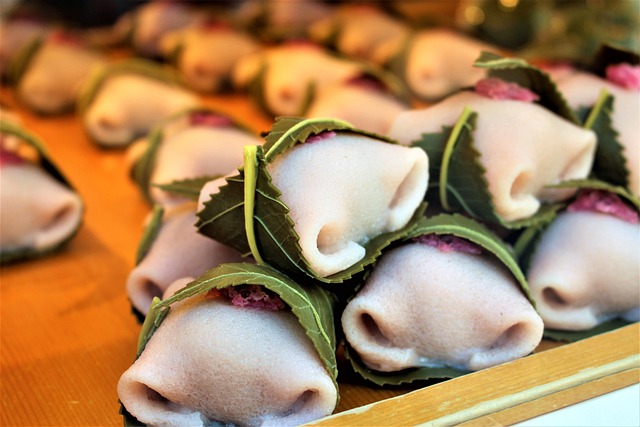
Sencha and Sushi: Sencha is the perfect complement to sushi, with its fresh and clean flavor serving to cleanse the palate between bites.
Hojicha and Grilled Foods: Hojicha is a roasted green tea that has a smoky and savory flavor, making it a perfect pairing for grilled meats and seafood.
Whether enjoyed on its own or paired with Japanese cuisine, tea is an integral part of daily life in Japan and an important aspect of the country’s cultural identity.
Japanese cuisine embody the essence of Japanese heritage, tradition, and innovation. From ancient dishes that have been refined over centuries to new culinary creations that blend international flavors with traditional Japanese ingredients and techniques, Japanese cuisine constantly evolves while maintaining its unique identity. Tea, too, has played an essential role in Japanese life for centuries, with its delicate flavors and sensory experience providing a moment of tranquility and reflection amid the bustling cities. Through food and tea, Japan offers not only a taste of its culture but a glimpse into its past, present, and future, making it a captivating and endlessly fascinating world to explore.
